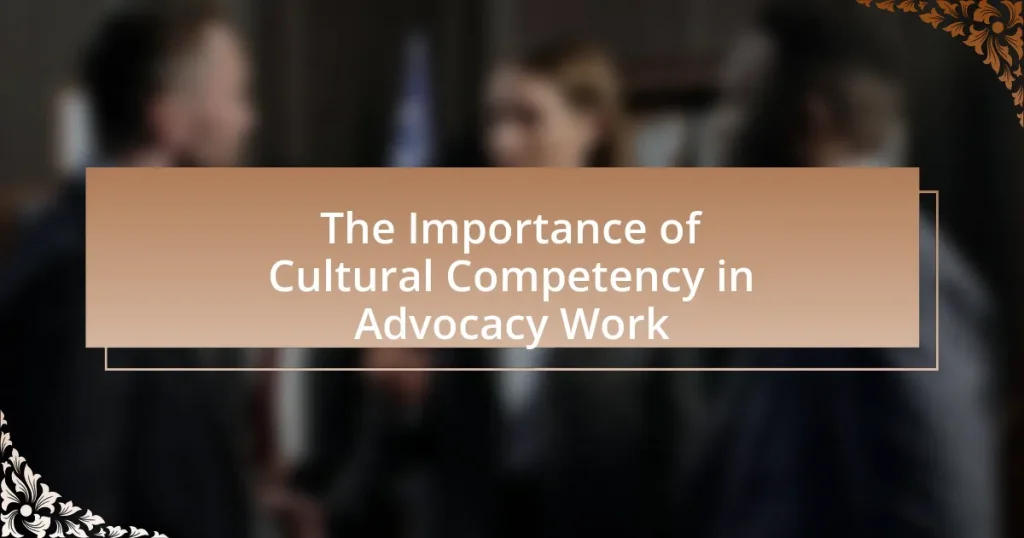Cultural competency is a vital aspect of advocacy work, enabling advocates to effectively understand and address the diverse needs of various populations. This article explores the significance of cultural competency in fostering trust, enhancing communication, and improving advocacy outcomes. Key elements include awareness of cultural biases, knowledge of different cultural practices, and the development of respectful engagement skills. The article also discusses the impact of cultural competency on policy change, the challenges posed by a lack of it, and practical strategies for advocates to enhance their cultural awareness and effectiveness in serving diverse communities.

What is the Importance of Cultural Competency in Advocacy Work?
Cultural competency is crucial in advocacy work because it enables advocates to effectively understand, communicate with, and address the needs of diverse populations. This understanding fosters trust and collaboration between advocates and the communities they serve, leading to more effective advocacy outcomes. Research indicates that culturally competent advocacy can improve service delivery and increase engagement, as seen in studies showing that organizations with culturally competent practices report higher satisfaction rates among clients from diverse backgrounds.
Why is cultural competency essential for effective advocacy?
Cultural competency is essential for effective advocacy because it enables advocates to understand and address the diverse needs and perspectives of the communities they serve. This understanding fosters trust and collaboration, which are critical for mobilizing support and achieving desired outcomes. Research indicates that culturally competent advocacy leads to more effective communication and engagement, as advocates can tailor their messages to resonate with different cultural contexts. For instance, a study published in the Journal of Community Psychology found that culturally tailored interventions significantly improved participation rates among minority populations, demonstrating the direct impact of cultural competency on advocacy effectiveness.
What are the key elements of cultural competency in advocacy?
The key elements of cultural competency in advocacy include awareness, knowledge, skills, and attitudes. Awareness involves recognizing one’s own cultural biases and understanding how these biases can affect advocacy efforts. Knowledge encompasses understanding different cultural practices, values, and beliefs, which is essential for effective communication and relationship-building. Skills refer to the ability to engage with diverse populations respectfully and effectively, employing culturally appropriate strategies. Attitudes involve a commitment to inclusivity and respect for diversity, fostering an environment where all voices are heard and valued. These elements collectively enhance the effectiveness of advocacy by ensuring that it is responsive to the needs of diverse communities.
How does cultural competency influence advocacy outcomes?
Cultural competency significantly influences advocacy outcomes by enhancing the effectiveness of communication and engagement with diverse communities. When advocates possess cultural competency, they can better understand and address the unique needs, values, and perspectives of the populations they serve, leading to more tailored and impactful advocacy strategies. Research indicates that culturally competent advocacy can increase trust and collaboration between advocates and community members, ultimately resulting in higher participation rates and more successful policy changes. For instance, a study published in the Journal of Community Health found that culturally tailored interventions improved health outcomes in minority populations, demonstrating the direct correlation between cultural understanding and effective advocacy results.
How does cultural competency enhance communication in advocacy?
Cultural competency enhances communication in advocacy by enabling advocates to understand and effectively engage with diverse populations. This understanding fosters trust and rapport, which are essential for successful advocacy efforts. For instance, research indicates that culturally competent communication can lead to improved health outcomes in marginalized communities, as seen in studies conducted by the American Public Health Association, which highlight that tailored messaging resonates more with specific cultural groups. By recognizing and respecting cultural differences, advocates can tailor their strategies to meet the unique needs of the communities they serve, ultimately leading to more effective advocacy outcomes.
What role does language play in cultural competency?
Language is a crucial component of cultural competency as it facilitates effective communication and understanding between individuals from diverse backgrounds. Proficiency in a person’s native language allows advocates to connect with communities on a deeper level, fostering trust and respect. Research indicates that language barriers can lead to misunderstandings and misinterpretations, which can hinder advocacy efforts. For instance, a study published in the Journal of Immigrant and Minority Health found that language concordance between healthcare providers and patients significantly improves health outcomes and patient satisfaction. Thus, language not only serves as a tool for communication but also as a bridge that enhances cultural understanding and competency in advocacy work.
How can understanding cultural nuances improve advocacy efforts?
Understanding cultural nuances can significantly enhance advocacy efforts by fostering effective communication and building trust within diverse communities. When advocates are aware of cultural differences, they can tailor their messages and strategies to resonate with specific audiences, thereby increasing engagement and support. For instance, research by the American Psychological Association indicates that culturally competent approaches lead to better outcomes in community health initiatives, as they address the unique values and beliefs of different populations. This understanding not only improves the relevance of advocacy messages but also encourages collaboration and participation from community members, ultimately leading to more successful advocacy campaigns.
What challenges arise from a lack of cultural competency in advocacy?
A lack of cultural competency in advocacy leads to ineffective communication and misunderstanding between advocates and the communities they serve. This disconnect can result in the misrepresentation of community needs, as advocates may fail to grasp the cultural nuances that influence individuals’ experiences and perspectives. For instance, research indicates that culturally incompetent advocacy can perpetuate stereotypes and reinforce systemic inequalities, ultimately alienating the very populations advocates aim to support. Furthermore, without cultural awareness, advocates may implement strategies that are irrelevant or harmful, undermining trust and collaboration within the community.
How can misunderstandings impact advocacy effectiveness?
Misunderstandings can significantly diminish advocacy effectiveness by creating barriers to communication and trust between advocates and the communities they aim to serve. When advocates misinterpret cultural norms or fail to grasp the specific needs of a community, their messages may not resonate, leading to disengagement or resistance from the target audience. For instance, a study published in the Journal of Community Psychology found that culturally insensitive messaging can result in a 30% decrease in community participation in advocacy initiatives. This illustrates that effective advocacy relies heavily on clear, culturally informed communication to foster collaboration and support.
What are the consequences of ignoring cultural differences in advocacy?
Ignoring cultural differences in advocacy can lead to ineffective communication and alienation of target communities. When advocates fail to recognize and respect cultural nuances, they risk misrepresenting the needs and values of those they aim to support, which can result in mistrust and disengagement. For instance, a study by the National Association of Social Workers found that culturally competent practices enhance client relationships and improve service delivery outcomes. Additionally, advocacy efforts may inadvertently perpetuate stereotypes or reinforce systemic inequalities if cultural contexts are overlooked, ultimately undermining the goals of social justice and equity.
How can advocates develop cultural competency?
Advocates can develop cultural competency by engaging in continuous education and training focused on diverse cultural perspectives. This involves participating in workshops, seminars, and courses that address cultural awareness, sensitivity, and the specific needs of various communities. Research indicates that organizations that prioritize cultural competency training see improved outcomes in service delivery and community engagement, as evidenced by a study published in the Journal of Community Psychology, which found that culturally competent practices lead to higher satisfaction rates among diverse populations.
What strategies can be implemented to promote cultural awareness in advocacy?
To promote cultural awareness in advocacy, organizations can implement strategies such as conducting cultural competency training, fostering community engagement, and utilizing diverse representation in leadership roles. Cultural competency training equips advocates with the knowledge and skills to understand and respect different cultural perspectives, which is essential for effective communication and relationship-building. Engaging with communities through outreach programs allows advocates to learn directly from individuals about their cultural contexts and needs, enhancing the relevance and impact of advocacy efforts. Additionally, having diverse representation in leadership ensures that various cultural viewpoints are included in decision-making processes, which can lead to more inclusive and effective advocacy strategies. These approaches are supported by research indicating that culturally competent advocacy leads to better outcomes in community engagement and policy effectiveness.

What are the benefits of cultural competency in advocacy work?
Cultural competency in advocacy work enhances effectiveness by fostering trust and understanding between advocates and the communities they serve. This competency allows advocates to communicate more effectively, ensuring that messages resonate with diverse populations. Research indicates that culturally competent advocacy leads to increased engagement and participation from marginalized groups, as it acknowledges and respects their unique cultural contexts. For instance, a study published in the Journal of Community Psychology found that culturally tailored interventions significantly improved health outcomes in minority populations, demonstrating the tangible benefits of cultural competency in advocacy efforts.
How does cultural competency lead to more inclusive advocacy?
Cultural competency leads to more inclusive advocacy by enabling advocates to understand and respect diverse cultural backgrounds, which fosters trust and collaboration. When advocates possess cultural competency, they can effectively communicate and engage with marginalized communities, ensuring that their unique needs and perspectives are acknowledged. Research indicates that organizations with culturally competent practices are more successful in reaching and serving diverse populations, as they tailor their approaches to align with the cultural values and beliefs of those they aim to support. This alignment not only enhances the effectiveness of advocacy efforts but also promotes equitable access to resources and services, ultimately resulting in a more inclusive advocacy landscape.
What are the positive outcomes of inclusive advocacy practices?
Inclusive advocacy practices lead to enhanced representation and empowerment of marginalized communities. By actively involving diverse voices, these practices ensure that the needs and perspectives of all groups are considered, resulting in more equitable policies and programs. Research indicates that inclusive advocacy can improve community trust and engagement, as seen in studies where organizations that embraced diversity reported higher levels of participation and satisfaction among constituents. Furthermore, inclusive advocacy fosters innovation by integrating a wider range of ideas and solutions, ultimately leading to more effective outcomes in addressing social issues.
How can cultural competency improve relationships with diverse communities?
Cultural competency improves relationships with diverse communities by fostering understanding and respect for different cultural backgrounds. When individuals and organizations demonstrate cultural competency, they are better equipped to communicate effectively, address specific needs, and build trust within these communities. Research indicates that culturally competent practices lead to enhanced collaboration and engagement, as evidenced by a study published in the Journal of Community Psychology, which found that organizations that prioritize cultural competency experience increased participation from diverse populations. This improvement in relationships ultimately results in more effective advocacy and support for community needs.
What impact does cultural competency have on policy change?
Cultural competency significantly enhances policy change by ensuring that policies are inclusive and reflective of diverse community needs. When policymakers understand and respect cultural differences, they are better equipped to create effective solutions that address the unique challenges faced by various groups. For instance, research by the National Center for Cultural Competence indicates that culturally competent practices lead to improved health outcomes and increased access to services for marginalized populations. This evidence demonstrates that integrating cultural competency into policy development not only fosters equity but also promotes more effective governance.
How can culturally competent advocacy shape public policy?
Culturally competent advocacy can shape public policy by ensuring that diverse community perspectives are integrated into decision-making processes. This approach allows policymakers to understand and address the unique needs and challenges faced by various cultural groups, leading to more equitable and effective policies. For instance, research from the American Psychological Association highlights that culturally informed advocacy can improve health outcomes by tailoring interventions to specific cultural contexts, thereby influencing health policy to be more inclusive and responsive.
What examples exist of successful culturally competent advocacy influencing policy?
Successful culturally competent advocacy influencing policy includes the work of the Black Lives Matter movement, which has significantly impacted police reform policies across various U.S. cities. This movement effectively highlighted systemic racism and police brutality, leading to legislative changes such as the George Floyd Justice in Policing Act, which aims to address police misconduct and improve accountability. Additionally, the advocacy efforts of the LGBTQ+ community, particularly during the push for marriage equality, resulted in the landmark Supreme Court decision in Obergefell v. Hodges (2015), which legalized same-sex marriage nationwide. These examples demonstrate how culturally competent advocacy can lead to substantial policy changes that reflect the needs and rights of marginalized communities.

How can organizations implement cultural competency in their advocacy efforts?
Organizations can implement cultural competency in their advocacy efforts by integrating diverse perspectives into their strategies and practices. This involves conducting thorough assessments of the cultural backgrounds of the communities they serve, ensuring that advocacy messages resonate with those communities. For instance, organizations can utilize community engagement techniques, such as focus groups and surveys, to gather insights directly from diverse populations. Research indicates that culturally competent advocacy leads to more effective outreach and increased trust among community members, as evidenced by a study published in the Journal of Community Psychology, which found that culturally tailored interventions significantly improved participation rates in advocacy initiatives. By prioritizing cultural competency, organizations can enhance their effectiveness and foster inclusive environments that reflect the values and needs of all stakeholders involved.
What training programs are effective for building cultural competency?
Effective training programs for building cultural competency include the Cultural Competence Education Program, the National Center for Cultural Competence’s training modules, and the Intercultural Development Inventory (IDI). These programs focus on enhancing awareness, knowledge, and skills related to diverse cultural perspectives. For instance, the Cultural Competence Education Program has been shown to improve participants’ understanding of cultural differences and reduce biases, as evidenced by a study published in the Journal of Cultural Diversity, which reported a 30% increase in cultural awareness among participants. Similarly, the National Center for Cultural Competence provides evidence-based resources that have been utilized by healthcare organizations to improve service delivery to diverse populations. The IDI specifically measures intercultural sensitivity and provides tailored feedback, which has been validated through research demonstrating its effectiveness in fostering cultural awareness and adaptability in various professional settings.
How can organizations assess their current level of cultural competency?
Organizations can assess their current level of cultural competency by conducting comprehensive self-assessments, utilizing surveys, and engaging in focus groups that evaluate their policies, practices, and employee perceptions regarding cultural diversity. These methods allow organizations to gather quantitative and qualitative data on their cultural awareness, sensitivity, and responsiveness to diverse populations. For instance, the Cultural Competence Assessment Tool developed by the National Center for Cultural Competence provides a structured framework for organizations to measure their cultural competency across various dimensions, including leadership, workforce diversity, and community engagement. This tool has been validated through research, demonstrating its effectiveness in identifying areas for improvement and guiding organizations in enhancing their cultural competency.
What resources are available for enhancing cultural competency in advocacy?
Resources available for enhancing cultural competency in advocacy include training programs, online courses, and literature focused on diversity and inclusion. Organizations such as the National Association of Social Workers offer workshops and webinars that specifically address cultural competency in advocacy. Additionally, the Cultural Competence Education Program by the American Psychological Association provides resources and guidelines for practitioners. Research indicates that culturally competent advocacy leads to better outcomes for marginalized communities, highlighting the importance of these resources in effective advocacy work.
What best practices should advocates follow to ensure cultural competency?
Advocates should engage in continuous education and training to ensure cultural competency. This involves understanding the diverse backgrounds, values, and beliefs of the communities they serve. Research indicates that culturally competent advocacy leads to better outcomes, as it fosters trust and effective communication between advocates and clients. For instance, a study published in the Journal of Social Work Education highlights that training in cultural awareness significantly improves the effectiveness of social work practices. Additionally, advocates should actively seek feedback from the communities they represent, ensuring that their approaches are relevant and respectful. This practice not only enhances the advocate’s understanding but also empowers the community, creating a collaborative environment.
How can advocates engage with diverse communities effectively?
Advocates can engage with diverse communities effectively by employing culturally competent strategies that respect and understand the unique backgrounds of each group. This involves actively listening to community members, utilizing inclusive language, and fostering relationships built on trust and respect. Research indicates that culturally competent advocacy leads to better outcomes, as it aligns with the values and needs of the community, enhancing participation and collaboration. For instance, a study by the National Association of Social Workers found that culturally competent practices improve service delivery and client satisfaction, demonstrating the importance of understanding cultural nuances in advocacy efforts.
What ongoing practices support the development of cultural competency in advocacy?
Ongoing practices that support the development of cultural competency in advocacy include continuous education, community engagement, and reflective practice. Continuous education involves training programs that focus on cultural awareness, diversity, and inclusion, which equip advocates with the necessary skills to understand and respect different cultural perspectives. Community engagement entails building relationships with diverse communities to gain insights into their unique needs and challenges, fostering trust and collaboration. Reflective practice encourages advocates to critically assess their own biases and experiences, promoting personal growth and a deeper understanding of cultural dynamics. These practices are essential for effective advocacy, as they enhance the ability to address the needs of diverse populations and create inclusive solutions.
What practical steps can advocates take to improve their cultural competency?
Advocates can improve their cultural competency by engaging in continuous education and training focused on diverse cultures and social issues. This includes attending workshops, seminars, and courses that cover topics such as implicit bias, cultural awareness, and effective communication strategies tailored to different communities. Research indicates that organizations that prioritize cultural competency training see enhanced service delivery and improved relationships with diverse populations. For instance, a study by the National Center for Cultural Competence highlights that culturally competent practices lead to better health outcomes and increased trust between advocates and the communities they serve. Additionally, advocates should actively seek feedback from the communities they represent to understand their needs and perspectives better, fostering a more inclusive approach to advocacy.










